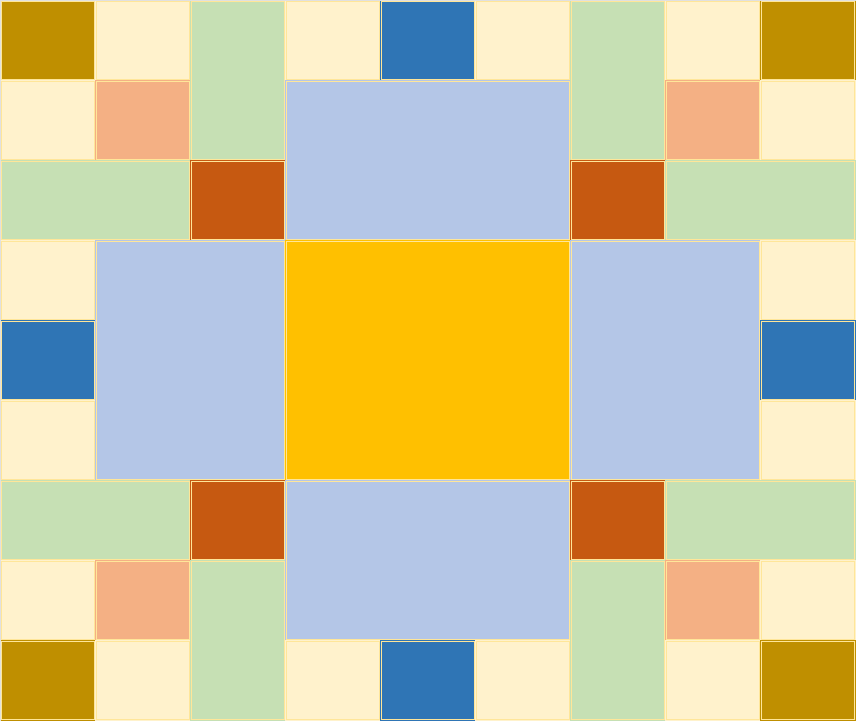Vastu Purusha Mandala with 9×9 grid
Honoring Vastu Purusha is a part of Puja rituals. A grid design of 3×3 or 9×9 cells is normally used as the Vastu Purusha Mandala in these rituals. Vastu Purusha is the Deva who rules dwellings or residences. What is the logic behind the idea of a ruler of dwellings? How is the Mandala used for design harmony? The story of the birth of Vastu Purusha gives us some insight. We can analyze the story in the context of a new human settlement.
Human beings claim a piece of land from nature and convert it into a settlement. Firstly, that piece of land comes under the purview of human consciousness. Secondly, it transitions out of chaotic or unintelligent control by nature. Thirdly, the settlers shape the land through their efforts and per objectives. However, human involvement can lead to either a positive or a negative change. Maintenace of design harmony leads to positive progress. A story in the Purana reflects this idea.

A drop of sweat fell from Shiva who fought an Asura called Andhaka. Darkness or blindness was the weapon of the asura Andhaka. During this hard fight, a drop of sweat fell from Shiva’s forehead. A Purusha or a Being arose from this drop. This being took his life purpose to be to devour Andhaka. He achieved this purpose and found himself hungry even after devouring the Asura. Therefore, he was ready to devour the Rakshasas and Devas who were in the vicinity.
Brahma intervened and got a group of forty-five Devas and Rakshasas to pin the Purusha Being down to the ground. This way the being could not cause destructions. In addition, Brahma granted some important boons. Firstly, he granted the title of Deva to the Purusha and named him Vastu. Secondly, he declared that Vastu will reign supreme over any Vasati or human dwelling. However, these boons are with the condition that the group of forty-five will hold Vastu flat to the ground. From then, Vastu Purusha remains in slumber most of the time.
The Vastu Purusha Story
Vastu Deva wakes up periodically and blesses inhabitants who honor harmony in a residence. However, Brahma has allowed him to be a troublemaker in a dwelling which lacks harmony. Consequently, town planners in the past strived for design harmony. They tried to balance the elements and the influences from different cardinal directions. For this, they picked the most suitable spots for water bodies, treasury, public spaces and community buildings.
Vastu texts are popular among architects even today. Designers in India and abroad incorporate at least important aspects of Vastu design harmony in modern buildings and residences. Vastu Mandalas are handy for this.
A Mandala of the Vastu Purusha is a square grid. However, this grid can have 1×1 to 32×32 columns and rows. Sometimes a priest draws a 9×9 grid using rice flour on the floor in preparation for Vastu Puja. He marks the location of forty-five Devas on this grid with distinct colors. Further he strengthens the energy of these Devas by reciting Mantras. Firstly, Vastu becomes happy when the powers of forty-five Devas become balanced. Secondly, the power from a grid of the Mandala can infuse to the respective part of a building.
An architect achieves this same effect by planning the location of the bedroom, water tank, bedroom, kitchen and entrance in Vastu-friendly corners of the house.
More questions about Vastu Purusha Mandala
A Hindu holds the idea that existence is interconnected. A Vastu Mandala provides him a way to honor the Devas or the forces of nature. These Devas play subtler roles inside a house.
It is worth researching two aspects about the Vastu Purusha Mandala further.
a) the logic behind assigning areas of the Mandala to different Devas: Understanding this requires us to appreciate an important assumption about the Vedic view of existence. Diversity in our domain of existence pales in comparison to the diversity in the subtle domain (the domain of Devas and other beings)
b) Forty-five Devas do not fit in Mandalas with lower number of grids: In that case Mandalas accommodate only twenty-five Devas or nine. Are such Mandalas less effective?
Many texts related to the science of Vastu were lost a 2-3 centuries ago. We may not know all the answers.
Related posts
The Yanta of Shukra